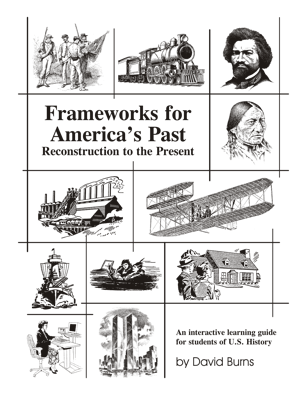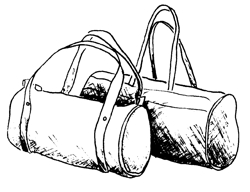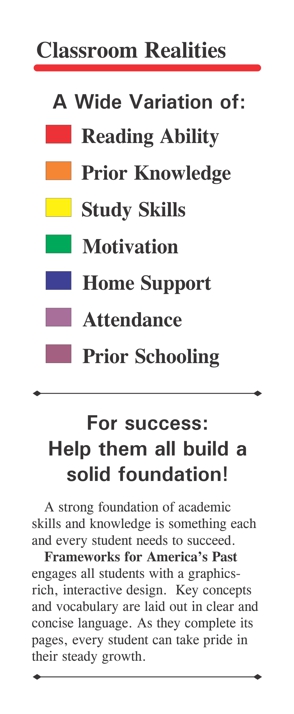 What is Frameworks for America's Past? What is Frameworks for America's Past? Frameworks
for America's Past is a 200 page
interactive learning
guide with a matching Internet site for middle school U.S.
history
students. It closely tracks the well regarded Virginia
USII history Standards of Learning (SOL), covering the period from
Reconstruction to the present. Frameworks
for
America's Past
uses a graphics-rich and interactive design that helps students of
all backgrounds build a solid foundation of knowledge and skills.
It has been used in hundreds of classrooms by thousands of students
across Virginia
and in other states. Frameworks for America's Past emphasizes active student engagement in:
Why do students enjoy working with this so much?  Most students are interested in
American history, but they
want to be involved
in the trip to explore the events and people
of the past.
Most students are interested in
American history, but they
want to be involved
in the trip to explore the events and people
of the past.With Frameworks for America's Past, students feel involved. Students learn and practice taking concise notes, on graphics-rich pages that help them visualize their lessons. They finish maps with color pencils, and make graphs of important historical trends using statistical data. With the matching Internet support site, they also explore an engaging collection of historical photographs, videos, primary source readings, and other resources. You, of course, are the classroom leader, and the lessons you build around the pages and topics in Frameworks for America's Past are an essential ingredient for student success. You can see all the pages, as they look with the notes, maps, and charts completed, on this web site. Look for the Teacher Key links in each unit listed on the home page.
The Internet support site has a full set of Teacher Key pages in each
section. These are sized
so they can be projected on
a large screen for the note taking parts of your classes, and for
activities and class discussion based on the pages. Be sure to see the Tips for Teachers page on this web site. There is a link to it from the Information Page for this title. Does it match the 2023 USII revised Virginia Standards of Learning (SOL)? Our Second Edition is largely based on the 2015 Virginia SOL for this subject approved in the spring of 2016. Like our earlier edition, it also includes additional material to flesh out certain topics more effectively. This edition does include the broad topics listed in the 2023 revised USII SOL, but doesn't include every specific item added by the revision committee. Unfortunately, the 2023 revision committee process resulted in participants stuffing a large number of new items into the USII SOL. If given as optional topics / names / events / issues for teachers to consider adding a few of to their lessons, the new items would be considered good suggestions. Taken all together as the mandatory list of required instructional items, however, the new USII SOL strikes many teachers as badly overstuffed and an unrealistic fantasy. It would be, in our opinion, a challenging list even for an AP level high school class to cover in any meaningful depth.  Overstuffed Standards of Learning
lists may look impressive on paper to some people, but they don't
improve instruction. Instead, they tie teachers up and result in a
tedious, boring dash through the content list, leaving little time for
engaging activities, projects, independent exploration, and class
discussions. As every traveler knows, pack the essentials in your
bag and you enjoy a really good trip. Overpack your luggage, and
it becomes a constant drag that ruins the whole trip. Overstuffed Standards of Learning
lists may look impressive on paper to some people, but they don't
improve instruction. Instead, they tie teachers up and result in a
tedious, boring dash through the content list, leaving little time for
engaging activities, projects, independent exploration, and class
discussions. As every traveler knows, pack the essentials in your
bag and you enjoy a really good trip. Overpack your luggage, and
it becomes a constant drag that ruins the whole trip.In our opinion, the 2023 revised USII SOL needs a serious review and trimming to make it a reasonable, realistic guide for teachers - and students - who actually are in our classrooms. Until that happens, we will stick with the generally reasonable framework the 2008 / 2015 SOL documents established for this subject. We encourage all teachers to add content and activities that you think your students would find interesting and meaningful on their trip through America's past. What about the cost? Announcement: All sections of Frameworks for America's Past are now available to individual teachers and parents as free PDF downloads, and include permission to photocopy the pages for use with their own students. Thank you for your past support for this project. Please see the Ordering / Downloading link on this title's Information Page for more details.  May
we place a link to pages on this web site? May
we place a link to pages on this web site?Teachers are welcome to place links from their own teacher web pages to this title's home page, to a section main page, or to other specific pages. You may not, however, take or copy content to transfer to your web pages. (Just like in a museum: You may visit and have your students visit, but you are not allowed to steal the exhibits!) For more copyright information, please click here. How can I get more information? Please contact our office in Springfield, Virginia, by phone at: (703) 644 - 4612, or by email at: ftm.contact@verizon.net |

 What
support is
available for teachers and students using this?
What
support is
available for teachers and students using this?